PARTICIPANTS
Michael Bordo, John Duca, John Taylor, Annelise Anderson, Uschi Baches-Gellner, Christopher Ball, Michael Boskin, Pedro Carvalho, Maidul Chowdhury, John Cochrane, Steven Davis, Rongrui Duan, Darrell Duffie, Christopher Erceg, Shana Farley, Andy Filardo, Jared Franz, Bob Hall, Robert Hetzel, Robert Hodrick, Nicholas Hope, Ken Judd, Kevin Kliesen, Donald Koch, Evan Koenig, David Laidler, Mickey Levy, Livio Maya, Michael Melvin, Thomas Mertens, Radek Paluszynski, Charles Plosser, Samuel Reynard, Flavio Rovida, Paul Schmelzing, Apostos Serletis, Richard Sousa, Christine Strong, Jack Tatom, Yevgeniy Teryoshin, Victor Valcarcel, Mark Wynne
ISSUES DISCUSSED
Michael Bordo, Ilene and Morton Harris Distinguished Visiting Fellow at the Hoover Institution and Board of Governors Professor of Economics and director of the Center for Monetary and Financial History at Rutgers University, and John Duca, Danforth-Lewis Professor of Economics at Oberlin College and vice president and associate director of research at the Federal Reserve Bank of Dallas discussed “Money Matters: Broad Divisia Money and the Recovery of Nominal GDP from the Covid 19 Recession.”
John Taylor, the Mary and Robert Raymond Professor of Economics at Stanford University and the George P. Shultz Senior Fellow in Economics at the Hoover Institution, was the moderator.
PAPER SUMMARY
The rise of inflation in 2021 and 2022 surprised many macroeconomists who ignored the earlier surge in money growth because past instability in the demand for simple-sum monetary aggregates had made these aggregates unreliable indicators. We find that the demand for more theoretically-based divisia aggregates can be modeled and that their growth rates provide useful information for future nominal GDP growth. Unlike M2 and divisia-M2, whose velocities do not internalize shifts in liabilities across commercial and shadow banks, the velocities of broader Divisia monetary aggregates are more stable and can be reasonably empirically modeled in both the short run and the long run through the Covid-19 pandemic and to date. In the long run, these velocities depend on regulatory changes and mutual fund costs that affect the substitutability of money for other financial assets. In the short run, we control for swings in mortgage activity and use vaccination rates and an index of the stringency of government pandemic restrictions to control for the unusual effects of the pandemic. The velocity of broad Divisia money temporarily declines during crises like the Great and COVID Recessions, but later rebounds. In each recession monetary policy lowered short-term interest rates to zero and engaged in quantitative easing of about $4 Trillion. Nevertheless, broad money growth was more robust in the COVID Recession, likely reflecting that the banking system was less impaired and could promote rather than hinder multiple deposit creation. Partly as a result, our framework implies that nominal GDP growth and inflationary pressures rebounded much more quickly from the COVID Recession versus the Great Recession. We consider different scenarios for future Divisa money growth and the unwinding of the pandemic that have different implications for medium-term nominal GDP growth and inflationary pressures as monetary policy tightening seeks to restore low inflation.
To read the paper, click here
To read the slides, click here
WATCH THE SEMINAR
Topic: “Money Matters: Broad Divisia Money and the Recovery of Nominal GDP from the Covid 19 Recession”
Start Time: October 18, 2023, 12:00 PM PT
>> John Taylor: Thank you so much for joining us, Mike and John. The title is a long title, but it's a good title. Money Matters, Broad Divisia Money and the Recovery of Nominal GDP from the COVID-19 Recession. So, Michael, I think you're gonna start us off.
>> Michael Bordo: Yeah, I'm gonna start us off.
And we'd like to have a few minutes to get into this without any questions.
>> John Taylor: No questions until you say it's okay.
>> Michael Bordo: Okay, no questions.
>> John Cochrane: I have an interest in this.
>> Michael Bordo: We'll open it up, no cuz it's from long experience here, that's why I'm doing this.
So it's great to be back. This is a paper with John Duca, we've been working on this a long time, and it seems to be pretty timely because now we are in a situation of inflation, which is coming down. Okay, click. Which one? This one.
>> Michael Bordo: Okay, and there was some issue about what were the causes of inflation.
But it seems like the fact that we had this high nominal GDP growth in 2021 along with inflation going above 20%, suggests that a good chunk of it was excess demand and not so much the supply shocks. And this just, again, just shows that nominal GDP has been rising way above its trends and suggests that inflation is a good aggregate demand excess demand story.
And so the traditional Chicago view, and I'm still one of the relics left from that time, which was the quantity theory of money, was that if velocity is stable in the long run, that too much money growth is eventually gonna fuel high inflation. So this is a very old story.
And in a sense, this paper does fit into that tradition. And what we do is we look at Broad Divisia Money, and we'll explain what we mean by Divisia, but there is this long-term relationship between money and nominal GDP growth. This picture kind of shows you that pattern.
But one of the issues that's been around for many decades now is that looking at taking a quantity theory monetarist approach really was not that successful in the past. Because of the fact that the demand for money for simple sum monetary aggregates like M2 really didn't work out too well.
There was unpredictability in the 1970s and 80s. And so central banks have moved away from using them. And what's sort of interesting now is that comparing the recent episode of the last three years with what happened after the global financial crisis, is that we had rapid money growth and we had inflation.
So we wanna get at this question of, well, if you look at the right measures or if you look at reasonable measures of money and of velocity, you might be able to show how money had a lot to do with the inflation that we've had. And so this shows you one reason why people have not focused on money.
This is simple sum M2, velocity, which has been pretty unstable in the period going back about 40 or 50 years. But there's been a lot of work out there for decades by Barnett and others that talked about using Divisia Money. And we'll explain in detail what that means, that it tends to work better than the simple sum and the simple sum monetary aggregates.
So what we do in this paper is we improve upon short-run and long-run models of the demand for or the velocity of the Divisia M3. And we find that doing it this way, we actually do get the stability which might have evaded us in previous decades, which says that if velocity is stable, then maybe looking at money can help us a lot in explaining the growth in nominal GDP and inflation.
And so this is the picture we have. So the V3 Divisa, John's gonna explain how we got that, but that does a much better job, I think, is much more stable than the simple sum V2.
>> John Taylor: Just clarification.
>> Michael Bordo: Yeah.
>> John Taylor: What is the velocity of money? How is it computed?
>> Michael Bordo: Okay, it's defined as nominal GDP divided by a monetary aggregate.
>> John Taylor: Okay.
>> Michael Bordo: Okay, so also during the global financial crisis, velocity of V3 fell quite a bit, because what happened was that the uncertainty associated with the crisis raised the demand for money, then it recovered. So there's a snapback, velocity fell, then it came back.
Same story happened in the pandemic. And so that the fact that you don't always get this really perfect correlation or even very close between M and P or wise, because velocity is changing. And so this picture here shows you what happened. So this is the velocity function that we're gonna look at.
And you can see these two big drops that happened during the global financial crisis and then just coming out of the recent COVID experience, okay? And so what's happened in the last two years is the Fed did shift to an anti-inflationary policy, as we've argued here at Hoover, they were behind the curve by at least six months, but they've caught up and they did start doing tighter monetary policy.
And this slowed Divisia M3 growth from being very rapid to being slightly negative. At the same time, you got velocity which declined during the pandemic and that is now coming back. And so in a sense, when you interact behavior of velocity with money, you can explain why it takes a while for these changes in monetary policy to show up in prices and nominal GDP because of what Friedman talked about in the old days.
>> Michael Bordo: Yeah.
>> Speaker 5: So you've left out a key fact, we've talked about this many times before, but it's really important now, and that is interest on the Fed pays interest on reserves. So that has an absolutely first-order effect in this analysis.
>> Michael Bordo: Yes, and that's part of the story of why we did not get inflation after the GFC because of that.
And what's happened now is that in a sense, the amount of money that they've been issuing is a lot greater, so there's a different story. And John will talk further about what happened, that's what's happening today from what happened 15 years ago. And we're gonna explain this as we go along.
And so the main point we're tryna make here is to say that if you can measure velocity, the demand for money, if you can measure it to account for lots of factors that are at work, institutional changes. That looking at Divisia M3 can be useful as an information variable for forecasting nominal GDP.
So we're not coming out in a sense, a pitch for going back to simple, just follow tight money and then you'll get low inflation, just follow money. We're saying that looking at the monetary aggregates is something worth looking at again. John, yeah.
>> John Cochrane: First of all, reserves are not Divisia M3, and that's very important.
I hope you will tell us how the Fed actually controlled the Divisia M3, cuz my impression was the Fed doesn't control monetary aggregates at all. There's no reserve requirements, there's no nothing, they just set an interest rate. And your last comment is very important because it goes from the correlation to causation question.
Division 3 people may demand more of it when inflation goes up, and they may demand post hoc, ergo proctor hoc, they may demand more of it ahead of time. That doesn't mean that it is the cause of the inflation.
>> Michael Bordo: Right.
>> John Cochrane: So I hope you're gonna get to, if you think it's the Fed's actions that slow M3 and that makes inflation go down, I hope you'll get to just how the Fed does that.
>> Michael Bordo: Okay, well, we will answer those.
>> John Cochrane: No, you don't have to do it now.
>> Michael Bordo: We will answer those questions. In a sense, we're taking a fairly conservative position here, we're not saying, go back to money. We're saying, money, if you measure, probably can be useful.
>> John Cochrane: Which you're saying, wait, wait, money caused inflation using for forecasting inflation.
>> Speaker 5: And that conditional and everything else we know, it adds greater power, that's another issue.
>> Michael Bordo: No, we're aware of that. Enforce your rule.
>> Michael Bordo: So, this is really my motivation and what we're gonna do, or I can turn this over to John and he's gonna do the heavy lifting.
>> John Duca: Thank you, Mike, and it's a great pleasure to be here. Of course, the typical Fed disclaimer applies. I'm gonna first talk a little bit about how you measure money with Divisia and then interpret our results from an IS-MP's perspective with the Fed targeting rates and trying to figure out where the IRS curve is during the pandemic.
And then I'm gonna talk about the results from modeling velocity. There are different COVID scenarios for the recovery of velocity, as Mike mentioned before, velocity typically falls during crises and then comes back. And talk about some of the implications for nominal GDP paths going forward. And then I'll conclude.
So let's first start off, we're all used to looking at simple sum monetary aggregates, where we just add up the components, we put the unitary weight on each component. Divisia is something that Bill Barnett and some of his co-authors have pushed, takes a different view, looks at measuring money.
Treats the price of monetary services as the differential between the interest rate on a risk-free asset that does not provide liquidity services, and the interest rate on a monetary component. And the idea is that one pays implicitly for monetary services by giving up this opportunity cost or user cost.
And the growth rate of a Divisia index equals the weighted average of the growth rate of components and each of the weights. So you could think about demand deposits, small time deposits, the like, as what's called average expenditure share. So you think about the expenditure that people spend on, let's say owning a demand deposit is equal to the user cost on that demand deposit times the amount of demand deposit balances.
You add that all up in a torquest tile sort of index or your aggregate, and you come up with an overall measure, okay? And as a result, growth in higher interest bearing money components gets less weight because it has lower opportunity costs and less implicit monetary services. Simple sum aggregates don't do that.
And we focus on using measures from the Center for Financial Stability, CFS in New York. We're gonna focus mainly on Divisia M3, which, the creation was ultimately inspired by Barnett's work. But a lot of the practical measurement was actually done by Dick Anderson and Barry Jones when they were at the Federal Reserve Bank of St. Louis.
And what Divisia M2 does, for example, is it aggregates the services from M2 balances. Davisia M3 adds services from large time deposits, repos, and institutional money market funds. And this internalizes a lot of shadow, what we call shadow bank money. If you go back to the days of the subprime boom, we saw large rises in institutional money market funds.
These are the funds that are owned by big financial institutions. And they bought a lot of short-term debt from some of the investment banks that were investing in subprime mortgage assets, as well as commercial real estate. And of course, that expands and collapses. And one of the nice things about using Divisa M3 is you're gonna capture that relative rise and fall, and that's really important.
>> John Cochrane: I have a general clarifying question, I'm I hope.
>> John Duca: Sure.
>> John Cochrane: What's the reference interest rate that is the risk-free rate with no financial services?
>> John Duca: Well, what CFS does, from what Barry Jones and I can figure, is they use a commercial and industrial loan rate, a prime rate, I think, a prime type rate.
It's a little difficult to find, you can't necessarily use a treasury cuz one can argue that treasuries can be-
>> John Cochrane: Well, this was gonna be my next question, Daryl, and I just came from the finance workshop where it's bandied about the treasuries themselves have 2 to 6% liquidity.
>> John Duca: And so, this is a great question cuz Divisia M4+ looks to serve adds in the services from treasuries as well as commercial paper. Divisia M4- adds the services from commercial paper-
>> John Cochrane: If we sort of view overnight repo as the reference rate, then pretty much everybody has within ten basis points.
I may be exaggerating overnight repo, it's not gonna make any difference, you're gonna be back to just cash. Whereas if you take 6% as your baseline rate, then you're just have a huge amount of money stuff that all is paying 2 or 3% less than-
>> John Duca: Right, but the thing is, well, it's the relative movements over time that are gonna be, when you aggregate up, that's gonna help.
>> Speaker 7: The big movement over time has been just a flip flop in the fraction of credit extended by financial institutions. Back in the 90s, it was 70% of credit extended, now it's 30%.
>> John Duca: Right, but they also hold a lot of mortgage-backed securities, and-
>> Speaker 7: It's a huge secular change that's occurred gradually and continually, maybe it's To an asymptote, who knows?
But I know you're paying a lot of attention to shorter term higher frequency movements, but it's against that big backdrop, it's worth noting.
>> John Duca: Yeah, and I think we see a lot of loans are securitized and marketed that way and priced that way. I take your point.
>> John Cochrane: Agency debt, all of this stuff is gonna be part of.
>> John Duca: Yeah, and you can use, our models work well for Divisia M3, Divisia M4-, Divisia M4+ model works a little bit better for Divisia M3 when we look at, when we try to model velocity. Now, I should move on in the interest of time and we can come back to some of these issues, thank you for your interest.
So Broad Divisia velocity falls in crisis but later recovers, and if you think, if you recall in a monstrous view, well, semi pseudo monetarist view, aggregate demand is money times velocity. So velocity, if you move money and then velocity goes down, but then later recovers, it's gonna impart long and variable legs, to use Milton Friedman's old.
And Anna Schwartz's view on the effects of swings associated with money growth. So let's, most of the younger folks are more interested, were familiar with an ISMP perspective. And so when the Fed pegs interest rates, money will grow faster if the IS curve shifts to the right. But in crisis you can have shifts going all over the place.
So for example, if we go back to the Great Recession, we had credit frictions from loan losses, uncertainty, tougher bank regulation, Dodd Frank was on its way. People kind of knew that all of this helped restrain the creation of money and credit. If you look at the Divisia M3 growth in the Great Recession, you see it falling quite a bit.
This is largely due to the collapse of the institutional money funds and large time deposits that are going on at this time. Now, if you think about, if we go back, talk about what happened in the pandemic, obviously the peanut butter hit the fan when the pandemic started, but loan losses and uncertainty were limited.
We had stronger regulation going into the crisis, so the bankers were in better shape. We had Fed support for corporate bond finance and we had a lot of fiscal support to firms. PPP loans were guaranteed by the treasury. Households had lots of fiscal transfers, and from our perspective, the reserve injections from quantitative easing and just general money based growth were able to greatly boost money creation.
If you look here, you see and ill be with you in a second, John, you see much more rapid money growth here in the COVID period than you do during the Great Recession. We had roughly the same amount of QE for 4 trillion. We had the funds rate being slammed down to zero, in fact, the funds rate cuts were smaller in this episode, but you had more rapid money growth.
Now, of course, when you're targeting an interest rate, you're making money endogenous. And so, what we're arguing is essentially that this is picking up some information. Yes.
>> John Cochrane: Reserves pay the same interest as treasury. So I don't see why a QE would make any difference at all to Divisia M3.
And also if M3 goes down, what goes up? Or is it just a price effect? I mean, do we get rid of money, we buy something else? Or is it just, well, the interest rate?
>> John Duca: Well, you could also remember that if you look at Divisia M4, those things are gonna pay pretty similarly.
>> John Cochrane: These are basic conceptual questions. Wait, you see M3 going down. Does that mean something else went up, exchanged money for some other?
>> John Duca: Well, to some extent, well.
>> John Cochrane: Services change.
>> John Duca: Hear you. In a world where bankers really aren't subject to reserve requirements, right? There is going to be, to a large extent, a lot of what money creation is gonna be.
There's a lot of endogeneity here. And in that environment, they're not going to create, for example, large time deposits plunged during this period. They're not going to issue a lot of managed liabilities to fund credit expansion. Here, that's not occurring. And so the environment's different, the money multiplier in a certain sense is a lot different.
And we think that there's information, let me move on a little bit from the interest of time. One thing is if the Fed is stabilizing nominal GDP growth over a long period of time, so take this period from like 93 to 2019. It includes, roughly this period is a pre inflation targeting period where inflation was roughly stabilized around 2%.
And then we had the more formal target in here. Well, if you look at, if the Fed is ultimately stabilizing nominal GDP growth over this period and velocity were roughly constant. Then average money growth would be roughly in line with nominal GDP growth, and in fact, that's the case.
If you interpret stabilizing nominal GDP as sort of Taylor Rulesque type behavior, then money growth comes out endogenously and you don't get any, the signals would roughly not cause you concern. But when you move to a period where let's say you're conducting a lot of unconventional monetary policy, it becomes very difficult to know where that IS curve is and what's going on.
Now, let me move on to modeling velocity, and then I'll talk about COVID scenarios, and then the implications for nominal GDP. So, in principle, if you had all the assets in the world and you created the Divisia index, its velocity shouldn't move much. But the fact of the matter is practically speaking, they're gonna be assets outside of the money components that you're tracking the services from.
But at the same time we know the liquidity of all competing assets, particularly stock mutual funds, which is an alternative for households to small time deposits. That has changed, and in fact mutual fund costs, particular loads seem to have made a big difference. We've had a big decline in mutual fund costs, particularly in the nineties, that caused some very big declines in small time deposits.
That caused a decline in money demand because velocity is adversely related to money demand. That's gonna push up the velocity of money. But we also saw some derivatives rules. I've done some work in the bond market and basically, and Tim Bolton has argued this as well. There's derivatives legislation nearly about 2000, the Commodity Futures Modernization Act that basically made it very hard to decipher the risk of companies.
For example, their derivative positions. And why does that matter? What CFMA did was it made derivatives contracts enforceable in a court of law. Before that, it was very unclear. As soon as they passed that credit default swaps soared, I mean, literally soared and took off. And provided a lot of the backing, particularly for subprime and commercial real estate stuff that got us into trouble later on.
But viewing it from an investor's point of view, what this act did was it made derivatives contracts get a bankruptcy priority before the bondholders and even the bank loans. So the derivatives contracts get paid before the widowers and the widows get their bond payments in case of a bankruptcy.
And you see some upward movement in bond spreads around that time as well that seems to be long lasting. Now, the other thing that affects velocity and let me. So if we look at the velocity of V3, sorry, rather the velocity of Divisia M3, there's a period of rising velocity.
This is a period of falling mutual fund loads that causes people to switch from small time deposits, which are trivial now. They were big back then, they're trivial now into stock mutual funds then later followed by the passage of CFMA. And you see people get shying away from these assets.
Remember Enron scandal? But also, its just tougher to figure these things out now. Let me move back. Now, sorry about that. The other thing that also happened was COVID obviously, right? So think about what happens during restrictions. You can't go out, you can't spend. You can't spend, you build up excess savings.
A lot of those savings take the form of excess money balances. You get your stimulus check. You can't go out on a cruise, you put it in the bank account. And then later on the restrictions get eased. Some people get vaccinated. And so what we try to do is try to control for that.
We proxy for it. Now, there's no perfect proxy. By interacting the Oxford Blavatnik center's index of government restrictions on behavior, times one minus the share, fully vaccinated. Most of us felt like we could do a lot more once we got our second vaccination shot and waited a week or so.
So what we're gonna do is we're gonna model long run velocity of the broad Divisia aggregates as a negative function of mutual fund loads. A negative function of the commodity futures modernization act era. And a negative function of this COVID vaccination slash government restrictions index. So if we look, let me show you some of the mutual funds data.
I have data going back a long time. The solid line is an inverted scale that's on this axis. This is the average load or percentage fee you pay for investing in a large stock mutual fund. It used to be around 8% in the early sixties, and it fell.
Remember, this is inverted to around 2% or so. But most of that decline occurred in here. The bars are the percentage of Americans, and it's on this axis that own stocks. With the light colored bar, part of the bars indicating the share of households that own stocks only through mutual funds.
Okay, the solid bar, the share that own directly. These things are negatively correlated with a coefficient of about minus one.
>> Speaker 7: How do you come up with 2% recently?
>> John Duca: Well, these are smaller size, non admiral type funds. Half of this is indexed. It is indexed, right. But there are still quite a few mutual funds that charge loads.
>> Speaker 7: Avid's charging nine basis points, sort of 2% as an average.
>> John Duca: Well, but I'm also trying to look at the median household here, cuz most of these assets are. Your point is well taken. So we're not including, for example, a vanguard admiral funds that have high balances.
>> Speaker 5: You're not including anyone at this table.
>> John Duca: Including me, yeah. Okay, fair enough. Let me move on. We already talked about the Commodity Futures Modernization Act, but we also have to deal with these short run effects, these crisis effects. So we have, in the short run model, we include movements in the BAA, long term treasury rate, to try to help control for some flights to quality.
But we have to put in something to control for COVID. And so this is a plot of the velocity of Divisia M3. It plunges. That's the purple line. And here we have the Oxford government stringency index. And in our model, we actually multiply this by one minus the fully vaccinated share for the COVID period.
It seems to track the temporary effects. So we have a long run model. So this is the long run model of velocity. We have a short run model where we're looking at the changes. It's an error correction framework. The error correction term is the log of actual velocity minus what we think the estimated equilibrium.
That coefficient, beta one, should be negative. So that changes in velocity move to close the gap between actual and equilibrium. And our samples span the era of the deregulated deposits. We go up through COVID. We also go up to the beginning of the pandemic, we also include the pandemic.
Key money demand results. We get unique and significant co integrating relationships pre and post COVID. By the way, if we estimate the model through 2005 or so, we get pretty much the same results same coefficients. Looks like it's stable in the long run. The coefficient signs all are expected velocities decreasing in mutual fund loads of the Commodity Futures Modernization Act and the COVID variable.
There's a four quarter lead of the estimated equilibrium that lines up the actual velocity. Let me just show you that. So, that lines up pretty well. Of course you're gonna have some temporary effects here, but we're moving back. The more recent estimates are somewhere kind of converging towards where the green line is seems like we're gonna go somewhere over here.
Let me move back a second. The short run models perform well, the model fits are clean are good and we could clean residuals. But then we have to create some scenarios. Because we don't know how people are going to react to COVID in the long run. Some people will prefer.
To wear masks for a long time and socially distance others, others won't, so what we do is we estimate some. We convert the models into autoregressive distributed lag equivalents which are easier to use, and we come up with some scenarios for recoveries in velocity, lemme talk about that a little bit.
So the government stringency index peaked at 72 when the pandemic really hit us in the second quarter of 2020. It's fallen to 27 by the end of the first quarter, it's probably fallen further and trying to get them to give us some more up to date estimates, vaccinations are plateauing near 69% or so.
We keep it pretty much there, what we do is we come up with a high or low medium and optimistic recovery. The optimistic basically says we're back to normal in 24q2 medium, well, we're gonna be somewhat below permanently low, we're gonna be even lower. We don't know, we don't know how people are gonna behave in the long run, I probably fall more towards these two, lemme show you a little bit about what.
>> Speaker 7: Restrictions that are still in place in 2023.
>> John Duca: Yes, there are in terms of so they would be things like restrictions on how many people you can pack into a restaurant, so it includes some of the local restrictions. No, these are great questions, they're relatively mild, I tend to like the high scenario, so it's going on, I'll be with you just a sec.
So here's the actual and we come up with some, we use our in sample coefficients, and we say, well, we don't know exactly how, but this is a range. Okay, and you can see the high, we're coming back to normal, yes John.
>> John Cochrane: I do wanna object a little to the causal language, velocity is fixed exogenously by things including how many vaccines are going on and the more m you put in, the more py.
But then you actually told the story, why did velocity actually go up when people, I mean, transaction demand for money goes down when you can't spend it? Well, you said we sent them a lot of checks and they just left it in their bank accounts. Well, that's a view that velocity is completely endogenous, you just send people checks.
They don't do much with them, they're not on a money demand curve, they're not really thinking about saving, spend it down. Well, they've been up, it's v equals py over m, whatever py is gonna be whatever m happens to be, that's what determines v, and you actually told that story,
>> John Duca: Well, think about-
>> John Cochrane: Well, that was an objection not a question.
>> John Duca: Okay, fair enough, okay, think about World War 2, we had serious rationing, we had very strong money growth, we had price controls. After the war we lift the price controls, people can go back to spending, we had a huge bout of inflation.
And in a certain sense, the government restrictions and the fear that people had, they waited, and-
>> John Cochrane: And they couldn't buy non monetary assets either. If you will, is that why do people sitting on checking accounts? I'll say, well, this is kind of dumb, I'll buy stocks with it.
>> John Duca: Well, but at the same time, interest rates are very low and, yeah, and people were a little worried about, yeah.
>> John Cochrane: Well, then money is a perfect substitute for everything else, we're out of business.
>> John Duca: I wouldn't say it's a perfect substitute, but I think we're taking the view that there's some information here.
So if we take these velocity paths, let's just do some scenarios with different growth rates of Divisia M3 going forward. Okay, whoops, sorry, we have a modest path, actually, Divisia M3 was contracting nominally at about a 4% annual rate in the early part of 2023. Actually fourth quarter of 2022 to the second quarter of 2023, we're assuming that it fell, that we wrote this paper a few months ago.
We assume that it fell further, then it flattens out and then it grows 4% magically from 2024, q1 on. This is the idea, you might interpret this as a sudden reversal in the expansion of the money supply. Either due to the banking, the banker's attitude towards creating liabilities in order to fund asset growth, or what the Fed may be doing.
The slow path here we are assuming that money growth just rebounds to a very sluggish pace in 2024, 4% thereafter. You can interpret this, some people may interpret this as the Fed easing off, let's say, in 2024 at some point, partial retrenchment. This is very tight policy or tight bank money creation, zero growth in 2020, 4% after our model assumes that velocity is stable in the long run, 4% nominal GDP, roughly 2% inflation, roughly 2% growth.
And let me just show you what the scenarios look like, yeah, good.
>> John Cochrane: I think I can state it more clearly, suppose in the pandemic, rather than sending people checks which counted as Divisia M3. The government had said, we're gonna send you all mutual funds that hold treasuries, it didn't count as Divisia M3.
Your prediction, you'd say, well, velocity is collapsing, so we're gonna have massive deflation cuz we didn't send people the thing they wanted. Where I would say, well, they're just gonna sit on those mutual funds exactly the same way they sat on the, they sat on the money.
>> John Duca: But they did, and I think, look at it this way, if you wanna get a slurpee at 711, you don't show up and pay the cashier with a $10,000 treasury bill, they wouldn't even know what it is.
>> John Cochrane: When you want to buy something, your question is this massive amount of assets just sat there, when you wanna buy something, you sell it and you buy something and you hold them-
>> John Duca: What would you do, would you hold zero? You could hold 0% interest earning treasuries or treasury bills or 0% earning bank deposits that can actually do something in case you need to run to the hills.
>> John Cochrane: My point exactly. If the government had sent them money market funds, easily sellable money market funds that own treasuries that weren't cash. If you think velocity is doing what it's doing, and that's the exogenous thing you predict, then there would be big deflation.
>> John Duca: Okay, my come back to you we'll have to get back to the presentation.
But my comeback to you is we've also estimated the Divisia M4, which includes the services from treasuries. So lemme move on, lemme show you some of these, so this is a plot of nominal GDP growth using the velocity scenarios with what we call the modest Divisia M3 growth scenario.
Where Divisia just starts growing at 4% first quarter, what's going on here? Well, you'll notice this period here we had high nominal, GDP growth. This is a period where money growth is slowing down. But velocity is going up because it's recovering, so you have to take into account both.
If you look in late 2024, 2023, you see a slowdown in nominal GDP growth towards 4%, depending on the scenario, okay? This is reflecting the combination of very the lagged effects of money growth turning negative in late 2022, first half of 2023 being weak in the fourth quarter, velocity still recovering some.
Then as money growth recovers and velocity still recovering, you get a temporary pickup, and then you converge towards 4%. If you extended this further out, it would go towards 4%. Another scenario which some people may think is more plausible is the slow growth scenario. That is, money growth slows to 2% in Q4 in 2024 and then reverts back to 20% to 4% in 2025/26.
And what this suggests is if we look at the more optimistic scenarios for velocity, that Steve and I tend to prefer, we get a return to about 4% nominal GDP growth in 2025. So this is kind of in line with the idea that inflation will probably get back towards normal somewhere around here, okay?
We may have a slowdown, we may have a growth recession, hopefully not a recession in here to get there. That's not that far from what we're seeing, and I'm gonna skip this scenario. This is a scenario where money growth is very, very tight, and then we're gonna see consistently below 4% nominal GDP growth, that's a tough slog for the economy.
Let me go to the conclusion, and we can open it up a lot more. So, we think that a lot of the recent inflation, not all of it. But a lot of it was funded by, fueled by expansionary fiscal and monetary policies and the simple quantity theory of explanation.
Too much money chasing too few goods, which have been discredited in the past, was done so because simple sum aggregates were failing us. And I think that that's pretty, pretty darn clear. We argue that there is some information in Divisia Ms, because you can model as velocity, and that can help you track the path of nominal GDP.
If you take into account that velocity falls during crises, there are gonna be delayed effects. Doesn't mean you don't flood the system with funds during a crisis, you do. But maybe you have to be careful about how much you do, and when you start to reverse that. The lagged adjustment of the velocity to uncertainty shocks helps explain the sluggish response of nominal GDP to slowing down and to inflation, to what we've seen.
And it suggests that also that the impact of recent Fed tightening since, let's say, sometime in 2022, depending on how you interpret Fed tightening, will be drawn out. And we think that is summarily ignoring money is not, there's some information there. And we should perhaps look more carefully at the Divisia aggregates.
And I would never focus on any one aggregate. But one of the things that Mike and I are gonna probably do with Barry Jones is look at seeing if Divisia M3 growth. Real Divisia M3 growth, adds something to, let's say, an index of leading economic indicators. And, thank you, and let me, let's open it up, yes.
>> Darrell Duffie: I wanna go to the, what's related to John's question, to the meaning of these Davisia services. So suppose I'm a corporate depositor and Fed funds is five and a quarter, and I'm getting 50 basis points, realistically, which is kind of a ripoff. Your story is I'm getting 475 basis points of services for holding my deposits at 50 basis points.
If deposit market competition picks up, as it has, the 50 goes to, let's say, 200, maybe. The fact that the rent that's taken by the banks from me through deposit market competition hasn't probably really changed the amount of services I'm getting from the deposits.
>> Darrell Duffie: I understand that my trade off is now tighter, and I get that.
But if that gap goes in half, does it really mean that the amount of services that I got goes in half? Isn't there a nonlinear effect here where I'm not really losing half of my services when competition pushes up the deposit rate halfway to the wholesale rate? Well, I would look at it this way.
If you're holding these assets with a very wide opportunity costs and you're a decent corporate treasurer, you better be getting some liquidity services from doing it, and you would object. And in equilibrium, that's, people will adjust. Takes a while, and we do have some, some lagged adjustment. My point is non linearity, is it really true that I'm losing a lot of services gradually over time, as that gap starts to narrow through increased deposit compensation?
I think for most, I think for what we're looking at with a lot of these aggregates, is look at the components, the big share of the components. You're gonna have some very liquid assets that do nothing, pay much of anything at all. You can have a lot of money funds that pay near market interest rates, you're gonna have a lot of large time deposits that pay near market interest rates.
An enormous amount of transaction deposits earning almost nothing, millions and trillions of dollars.
>> Michael Bordo: I've looked at the numbers. Is that a US only phenomenon, or would that be true in other large economies as well? I actually asked somebody in Brazil about increased deposit market competition, how it's affecting interest rates.
He said, we actually, in Brazil, we don't allow our banks to pay interest on deposits. So I guess it's probably not unusual around the world. It does highlight that a lot of movements and what, when you do a Divisia M3, a lot of the movement and the quantity of money is not goNNA be about the change in the number of dollar bills.
It's gonna be a change in the interest rate and therefore the imputed moneyness of those dollars. That's my point, I mean, I get-
>> John Duca: That this trade off is being made.
>> Michael Bordo: But I don't get that it's linear in this gap, doesn't seem like more time invariant, it seems like.
>> John Duca: It does assume that the approximation does assume that it is proportional to the user cost, in that sense, you're right.
>> And I think that's part of the reason why when you get into these crises, you see some of this unusual behavior. There's something else going on, yes.
>> Michael Bordo: Larry Mara has a, Larry, do you have a question?
>> Okay, first, This was a really interesting paper, and you get an A plus for effort. That was just a lot of work. That's another vote. But I don't believe that this story was about demand. It was mainly about supply.
The board staff, FOMC participants agree it's becoming more of a consensus, minor point. Now, I think that what I liked about the paper was you didn't overstate your results, you didn't try to project them as relevant to all of history, but you focused on this narrow period. Now, I wanna tell you what would convince me on this on a more longer period, and that is, I don't wanna have you take back my PhD.
But in the second chapter, does money matter?, I did it this way. Do you think these Divisia indices would come in to aggregate demand equations? You must if you really believe this story. Did you try? Okay, I did, with all kinds of monetary aggregates. I let interest rates and cost of capital have the first opportunity, as theory would suggest.
And then I asked if any of the different measures, not Divisia mattered, and they didn't, so I would be impressed, and I don't know that we're really that far apart here.
>> Michael Bordo: But I would be impressed if you looked at that and told me over the COVID period, so strange, I have no particular views.
>> I think it's an excellent point, Larry, and thank you for making it. This is part of the reason why we wanna see how much does some sort of velocity adjusted Divisia aggregate, let's say, add to, let's say, the leading index. By the way, the conference board ditched including real M2 growth.
>> Michael Bordo: Real M2 as one of its components of the index of leading indicators, because it had serious problems with velocity and was actually messing things up.
>> John Duca: In fact, this is a chart of M2 growth.
>> That's the Green and Divisia, and particularly in the great recession, you see robust M2 growth.
What's happening here is where you see much weaker Divisia M3, and also during the recovery.
>> Michael Bordo: Remember, the recovery was very long, right?
>> And what's going on is the shadow system's falling apart. People are fleeing institutional money funds, large time deposits are contracting. Banks are facing tougher capital requirements.
They don't wanna hold a lot. They wanna have the asset growth that they had going in. And so a lot of the composition of Divisia M3 or M3 is shifting towards M2, and you're ignoring that substitution. So I agree with you, Larry, that there's more work to be done.
But I think that summarily, just saying simple sum aggregates have terrible velocity, therefore we never look at money again, I think that we should revisit this. The other thing I would also say is, from a predictive standpoint and a forecasting standpoint, how much history do we have with quantitative easing to really get a handle on how it affects long term rates and the like?
We have a very short history. It's very difficult to think about, what about these other things that are going on? We've had major changes in bank regulation that affect bankers' willingness to create liabilities in order to fund asset growth. And we've had other things going on as well.
And I think this is some information here. It goes back to Poole's point a long time ago, but let's move on, sorry. Let me just bring a point about QE, very important, what you mentioned.
>> Michael Bordo: But QE wasn't about quantitative easing, it was about duration.
>> Okay. It wasn't because reserves went up so much.
It was because of duration and term premium being compressed. Just another view. Okay, I'm done. Okay, thank you, Barry Bus. Yeah, I had a bunch of comments and questions. So I'll try to do them quickly. But you got me thinking about a lot of things from Bordeaux, the economic historian here.
First of all, I tend to think of all this as falling into three eras. The era of Reg Q and regulated rates and deregulation. And then, Bob, I think, appropriately mentioned the era of paying interest on reserves. And I think those are really regime shifts. And how you deal with those, I think, is important.
And I'm not clear you convinced me that when you look at the long data, that you have a convincing story about that. Secondly, a lot of this is really a portfolio allocation issue, right? And as you're going through all this, you're showing this happened here, this happened here.
It's people, time deposits are collapsing, and this is going here, etc. And certainly Divisia aggregation, which at least allows substitution rather than fix weights, is, I think, fundamental. I go back to Bob Hall making me understand that when he was teaching me Jorgensen and Grille, cuz his productivity studies and arguments with Ed Denison, when he taught me econometrics.
So, substitution is important and getting the right amount of substitution, and whether a lot of these things are perfect substitutes or almost. So, as John Cochran is saying, that's something you ought to spend some more time thinking about. And also whether you can get stable or useful real time estimates of those weights, I think, is another issue.
And then you made all these predictions, and they're all about nominal GDP. And then you kind of indicated, it seemed like you had some exogenous notion of supply in the background. But these events, at least in the short run, affected supply as well. And I'm just wondering how that fits into your story.
Well, one thing we did do is we estimated the model over the period where deposits were deregulated.
>> Michael Bordo: Where money market mutual funds were allowed and made the transition, where money market deposit accounts another major factor.
>> John Duca: Most savings deposits really are money market deposit accounts, for example.
>> So we estimated over the deregulated period, there are problems with Divisia when you go to this period, this transition, because the transition you have artificially wide opportunity costs.
>> Michael Bordo: And then you have people literally jumping to money market mutual funds, and the opportunity cost is a lot smaller.
>> And if you just do a simple mechanical thing, you're going to say that money is collapsing, right? It's kind of what you were talking about before. We didn't make that mistake. And I think that that's also something that one of the things that Barry, Mike and I are going to try to do is deal with that issue.
>> Michael Bordo: Cuz Divisia fundamentally is based on optimization behavior in the absence Of constraints.
>> Absolutely, well, and solving differential equations, yeah, okay I mean, the short version is, why did money not go up during QE? The longer version is, it's been very, in my thinking, it's been very influential that in the pandemic, there was a total amount of nominal assets that increased.
This was, we printed money and we funded deficits with it. And so there's a wealth effect, whereas in QE, there's exactly the same amount of fed buying stuff, but there was no big deficit. So those to me look to me like the perfect test of monetarism, which is about the portfolio balance effect versus fiscal theory, which is about the overall quantity of, it's a wealth effect opposed to a portfolio balance effect.
And they seem exactly the same. $3 trillion, the fed buys $3 trillion and give you 3 trillion reserves. In one case, nothing, no inflation. In the other case inflation. But you're showing that the QE did nothing for Divisia M3, which is so, one, just mechanically, how is that?
And two, if you think the Fed is controlling M3 and $3 trillion of QE doesn't do anything, how does the Fed. No, no, we influence it. Let me show you this chart here for the example. And this is something I think is important. The solid, regular black line is Divisia M3 growth.
This heavy line here is a loan. This is the charge off rate on overall bank loans from the Federal Reserve data. And so if bank loan losses are rising, bankers are not willing to make as many loans when they're not able to, also because of capital requirements. This is one factor, and here bankers are protected.
You've got the PPP loans, you've got all this fiscal support going on. The loan loss rate is flat as a doornail. And so they're more apt to take the big amounts of liquidity in the system and also expand upon what the Fed is doing, and you get stronger growth.
The other thing to keep in mind is Dodd Frank was proposed right around here, and that's jacking up capital requirements big time, and also it's restrictions. And that's also gonna, and then we had all other kinds of restraints on banks being proposed. And so in this period, you don't get as much robustness.
>> Michael Bordo: Here at least in this period, we didn't have any change in bank regulations per se, other than that we did get rid of reserve requirements.
>> But I would also say that bankers were much more willing to lend, and they didn't pull back as much. And then we also, by the way, had another thing that's also going on in the background that a lot of people forget is we had major Federal Reserve support with the backing of treasury in the corporate bond market.
Those spreads did not blow out to 5.56% like they did over here. They stayed at around three. And so you didn't get the financial accelerator effects, Oliver Bernanke and such and company kicking in. You can't necessarily pick that up by looking at just traditional indicators. There's some information going on in here.
We're not getting that amplification that takes the economy down. So that's why I think of it as an information variable, very endogenous. There are a lot of other partial programs going on in all these periods. Some fiscal, some monetary, right. For example, while things were being clogged in the financial crisis, when they finally said they finally had a commercial paper facility, it reopened overnight basically.
>> Michael Bordo: Right.
>> Okay, so there's stuff like that that happens instantaneously and affects how you're aggregating these numbers, so.
>> Michael Bordo: Yeah.
>> John Duca: But we wanna get some fuller story than just we have to explain every episode with five special features.
>> And then, so again, I get to what's, if you can put this in and show some conditional value with traditional macro stuff in it above and beyond what they're already able to do, that would be great.
I think that's where you're trying to head. But that would be valuable, I think. But this gets to John's question, John Cochran's question. I mean, because he's right. When you have big fiscal expansions like wars and stuff. Okay, the Fed accommodates that other paper I gave last year on the bank of England.
That's a very compelling story. And that's when you see inflation. So in a sense, there was a difference between the GFC, what they did and what they did recently. And I think that, and that is part of the story. It wasn't the federal government throwing all this money and depositing these checks in people's accounts.
It's a different scene, I think. So I think like when you get into these races between the fiscal theory, the price level and a monetarist approach, you end up with the conclusion that they're observational equivalents. And I teach this stuff in my courses and you can tell a story that's consistent with him and also one that's consistent with them.
So I think that there is something to that. Well, not quite the open market operation, they take one thing and give you another is qualitatively different from I give you some more of both.
>> Michael Bordo: US fiscal deficits following 2008 were, as I recall, just as large a fraction of GDP as the deficits following COVID.
>> So I'm not sure that the really separation between fiscal and monetary in those two events.
>> Michael Bordo: There actually is, but I don't wanna get into it, yeah.
>> John Duca: I think it occurs a little bit.
>> It's a little, I think in COVID, the deficits were a little bit bigger, a little more extended, but at the start they were not that much different.
Yeah. Yeah, your next last point suggests impact of recent Fed tightening will be drawn out. I don't quite understand, especially in the context of the chart.
>> Michael Bordo: Sure, absolutely.
>> You had the funds rate a half percent through most of last year. Excellent question. So if we go back to the velocity chart, we're over here at the first quarter of 2023, right.
So we're in a period where velocity is still going to go up. So if velocity is going up while money is going down or staying flat, you're still gonna have some growth in aggregate demand. This is because.
>> Michael Bordo: Forecast that the restrictions are still easing.
>> Yeah, and that people are going back to normal.
I think more and more of the masks will come off and people will go back to the cruise ships and all that. The model wasn't dynamic except for velocity being a function of things that are disappearing. So that's where the dynamics. Yeah. And so there is this, we still have further to go.
Oops, this gets back to Steve. I don't get that. So the idea is that velocity is still likely to rebound here, we're over here, we're gonna probably go further up. And so until we peak, until velocity stops going up, then there's gonna be a delay and that's slowing really.
It's gonna delay the full slowing of nominal. GDP growth. And that's why we get this. Oops, I'm sorry. Let's go forward. That's why we get some of this pattern. It takes a while to get back towards. At this line, we go back to 4% right around here. Three and a half, 4% it's hand grenades and horseshoes.
But you had this picture where the funds rate was half percent way onto 22. No, no, no, we're not sharin the funds right. You should share. You just had a chart. No, that was the past. That was the past, yeah I'm sorry. In this chart here right, yeah.
In this chart here, this was only through
>> Michael Bordo: Funds rate.
>> The funds rate is the dashed line. Yeah, but look, it's into 22, half a percent. No, no, this is the dash line. The dash line is the funds rate
>> Michael Bordo: Goes up to four.
>> John Duca: Goes upto four.
>> The heavy line is the loan loss rate
>> Michael Bordo: Wasn't very clear, yeah.
>> Well, it says effective funds rate.
>> Michael Bordo: That's this one here.
>> That's the dashed line. I meant it to be there. I should have put that. I should have read that. Stay on this graph a second.
Sure. Because with Daryl's point in mind,
>> Michael Bordo: Yes.
>> John Duca: My point of accuse, just understanding mechanically, why does Davisia do what it does?
>> And so that would seem, on the right-hand side of this graph, the interest spread on deposits goes from nothing to 4% and yet we're seeing Davisia M3 collapse.
I would have thought it would explode because now we count the exact same deposits as not ten basis points versus monetary services. No, it's going on if the funds rate rises and induces rises in interest rates and the benchmark rates gonna go up, and then you're gonna get some adjustment and people may decide not to hold these high opportunity cost assets.
Remember,
>> Michael Bordo: But we're not seeing a collapse in deposits.
>> We're seeing a decline in Divisia M3 absolutely. But not to make up for a ten basis point to four percentage point money survey. It's slowing. I mean, we're going from, look at the scales over here. We're going from, let's say, 10% growth at the end of 2021.
We're actually, if we extend this further out, this is year over year. These are growth, John. These are growth rates it's been minus 4. Saying the quantitative flow out of deposits is enough to overcome the higher interest spread that you're calling more moneyness. But also remember that some of those rates, the money fund rates, are moving pretty darn close with the benchmark rate, yeah.
>> Michael Bordo: So rates are gonna be moving up with it, but maybe not.
>> John Duca: Spread is not moving up as much as might be indicated might be thought.
>> You got spreads and quantities moving. Yeah.
>> Michael Bordo: I mean, so there's a lot going on there.
>> It's an aggregation.
I see your point. The spread is not. I finally understand Darryl's point. Of course, a growth of 0 means nothing's happening, it's just less. Okay, got it. Thank you. Sure. No, so the great majority of economists at the FED, and academics as well, subscribe to the new Keynesian view.
The new Keynesian view gives very little weight. The basic three-equation version does not have money in it, because the monetary policy is completely summarized by the short-term real rate. And the real rate story, I think, is pretty plausible, as long as the chair of the FED, doesn't seem to understand that it's the real rate and not the nominal rate.
But if you translate what's happened in the last three or four years into real terms, the real rate plunged. And at the time when inflation skyrocketed, and then as it's come down, we've had a huge increase in the real rate over the past year, as the instantaneous real rate is basically back down to 2%.
>> John Duca: So, it seems to me that the new Keynesian view can't be just dismissed, it has a lot going for it.
>> Michael Bordo: I'm not dismissing it.
>> What I'm trying to say here is if we think about where the IS curve is, right?
>> Michael Bordo: Yes.
>> John Duca: And one of the issues with the new Keynesian approach is you have to know what the Vixellian neutral real rate is, which has been moving all over the place.
>> You've got to deal with loan rates as well. Okay. And where the position of the IS curve is, you're making guesses during a pandemic, right? And what I kind of view this as if you're in a pandemic, or you're in a crisis and you're gonna have some unusual effects, you may need to have some sort of contained discretion approach, but you wanna get as much information as you can.
And in a pooling world, where you're having IS shocks, if you can control for the velocity of a monetary aggregate, you can get some information from it. And that's where we're coming from. I mean, think about the problems we had in the Great Recession, we had tremendous, tremendous shock to the financial stability and financial resilience.
And we had big hits to household wealth. We had a whole slew of things hitting and the economy and the recovery were weaker than we had thought it would be. And yet when we had the COVID recession, if we go back to the spring of 2020 and we look at some of those projections, I mean, folks, let's face it, a lot of people thought we were looking down the barrel of the Great Depression, okay?
We were, you know, when is this thing gonna end and all that? Well, to some extent, you get the vaccines, spending comes back, people start drawing down their excess savings or, spending their excess money balances, however, you wanna interpret it.
>> Michael Bordo: You're gonna see some, some recovery in aggregate demand.
>> And so, that's why I emphasize there's an information variable, it can be useful. I don't think that if you go back to Bruner and Meltzer, there are shocks to both the liability side and the asset side of the bank balance sheet, and they both matter. Whereas Woodford and company took a rather strong view.
He took interest out of the title of Dom Patekins. Absolutely.
>> Michael Bordo: Yes, I congratulate him for it.
>> Well, I think I'm actually more on the credit side of things, but I think that there's still some information there. Mickey has a Question there please.
>> Michael Bordo: Yes, going back to post financial crisis, I mean, I think I agree with you about the information in the variable because there was through the Fed's QE One, Two and Three, you had this huge increase in reserves and base money, but no decided acceleration in either Davisia or M Two.
>> But then if you look at the broader context there, the banking system was crippled and had no capital. They were facing stress tests and the supervisors bearing down on them. They were not making loans, so bank lending was falling, and at the same time, housing was crippled and so were the consumer balance sheets.
And so the base money was not put to work. If you can compare that to the post COVID. The banking system was very well capitalized. Household balance sheets were flush, and it was much more similar to the post World War II era where there was just this surge of spending and velocity following World War II.
And so I kind of like what you say about the information in this. And I would just add a final point. Wait till you see third quarter nominal GDP. You're gonna see a surge quarterly in both your tubesia and your M Two velocity. And it looks like the lags are working and there is important information in your monetary approach.
I think that, well, we sort of agree with you, Mackie. Maybe, yeah.
>> Michael Bordo: I wanted to say something.
>> I wanted to get back to what Bob Hall said. So one of the things we're thinking of doing is translating this into interest rate space. I was thinking of we look at the Taylor Rule and then we can translate the Davisia into where are we relative to a Taylor rule.
And I think there's a way you can do that, just the way that, people during the zero lower-bound period, people were estimating sort of, pseudo or, I guess that's the right word, Taylor rules. And they were showing that the gaps were pretty large in that period when interest rates were frozen.
So I was thinking if we could translate this into that language that could then be able to be explained to people who forgot about M and V and all that. Woodford has been accused of a major crime, but I think what he did was genius, and it's what our graduate students are taught.
>> Michael Bordo: Well, and there's a reason because the Fed does not control the quantity of money.
>> So if the Fed does not control the quantity of money, MVPY may work wonderfully. It describes the demand for elastically provided money every time, which is very interesting. As I buy ball bearings or inventory I buy Cheetos.
We have an inventory of Cheetos in the house. And as nominal GDP goes up, we hold more nominal Cheetos in the house. But that doesn't mean you control GDP by controlling Cheetos.
>> Michael Bordo: Right.
>> John Duca: Unless the Fed controls the quantity.
>> Michael Bordo: Whereas the Fed's control of the interest rate is absolute.
>> The monetary directions specify. Well, that's the way they're going now. They could try to control. By the way, I have another question. We have gross domestic income as well as gross domestic product. And when you're talking about the kinds of things you're talking about, seems like the income side.
And of course, recently there's been a huge diversion, statistical discrepancy in which income hasn't risen nearly as much as output. Right, and that would suggest that. Well, yeah, that would have a different path. Significantly different path.
>> Michael Bordo: Yeah.
>> Worryingly large. Yeah. Bob, didn't this get traced down to the accounting of the Fed's remittances to the treasury?
I'm sort of vaguely remembering Jason Furman explaining this, and you, if anybody would know. Well, that says that nobody knows. You guys want to conclude or you're-
>> Michael Bordo: No.
>> John Duca: Any questions, comments?
>> You're fine.
>> Michael Bordo: Yeah.
>> Okay, thank you so much.


















